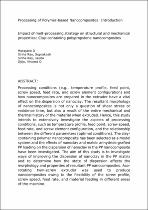 ResearchSpace
ResearchSpace
Impact of melt-processing strategy on structural and mechanical properties: Clay-containing polypropylene nanocomposites
JavaScript is disabled for your browser. Some features of this site may not work without it.
- ResearchSpace
- →
- Research Publications/Outputs
- →
- Book Chapters
- →
- View Item
| dc.contributor.author |
Morajane, D

|
|
| dc.contributor.author |
Ray, Suprakas S

|
|
| dc.contributor.author |
Sinha Roy, Jayita

|
|
| dc.contributor.author |
Ojijo, Vincent O

|
|
| dc.date.accessioned | 2019-02-02T12:44:24Z | |
| dc.date.available | 2019-02-02T12:44:24Z | |
| dc.date.issued | 2018-02 | |
| dc.identifier.citation | Morajane, D. et al. 2018. Impact of melt-processing strategy on structural and mechanical properties: Clay-containing polypropylene nanocomposites. In: Processing of Polymer-based Nanocomposites: Introduction, pp. 127-154 | en_US |
| dc.identifier.isbn | 978-3-319-97778-2 | |
| dc.identifier.isbn | 978-3-319-97779-9 | |
| dc.identifier.uri | https://doi.org/10.1007/978-3-319-97779-9_5 | |
| dc.identifier.uri | https://www.springer.com/us/book/9783319977782 | |
| dc.identifier.uri | http://hdl.handle.net/10204/10662 | |
| dc.description | Copyright: 2018 Springer. Due to copyright restrictions, the attached PDF file only contains the abstract of the full text item. For access to the full text item, please consult the publisher's website. | en_US |
| dc.description.abstract | Processing conditions (e.g., temperature profile, feed point, screw speed, feed rate, and screw element configuration) and how nanocomposites are prepared in the extruder have a vital effect on the dispersion of nanoclay. The resultant morphology of nanocomposites is not only a question of shear stress or residence time, but also a result of the entire mechanical and thermal history of the material when extruded. Hence, this study intends to extensively investigate the aspects of processing conditions, such as temperature profile, feed point, screw speed, feed rate, and screw element configuration, and the relationship between the different parameters (optimal conditions). The clay-containing polymer nanocomposite has been selected as a model system and the effects of nanoclay and maleic anhydride grafted PP loading on the dispersion of nanoclay in the PP nanocomposite have been investigated. The aim of this study is to investigate ways of improving the dispersion of nanoclay in the PP matrix and to determine how the state of dispersion affects the morphology and properties of resultant PP nanocomposites. Aco-rotating twin-screw extruder was used to produce nanocomposites owing to the flexibility of the screw profile, screw speed, feed rate, and material feeding in different areas of the machine. | en_US |
| dc.language.iso | en | en_US |
| dc.publisher | Springer | en_US |
| dc.relation.ispartofseries | Worklist;21774 | |
| dc.subject | Nanocomposites | en_US |
| dc.title | Impact of melt-processing strategy on structural and mechanical properties: Clay-containing polypropylene nanocomposites | en_US |
| dc.type | Book Chapter | en_US |
| dc.identifier.apacitation | Morajane, D., Ray, S. S., Sinha Roy, J., & Ojijo, V. O. (2018). Impact of melt-Processing strategy on structural and mechanical properties: Clay-Containing polypropylene nanocomposites., <i>Worklist;21774</i> Springer. http://hdl.handle.net/10204/10662 | en_ZA |
| dc.identifier.chicagocitation | Morajane, D, Suprakas S Ray, Jayita Sinha Roy, and Vincent O Ojijo. "Impact of melt-processing strategy on structural and mechanical properties: Clay-containing polypropylene nanocomposites" In <i>WORKLIST;21774</i>, n.p.: Springer. 2018. http://hdl.handle.net/10204/10662. | en_ZA |
| dc.identifier.vancouvercitation | Morajane D, Ray SS, Sinha Roy J, Ojijo VO. Impact of melt-processing strategy on structural and mechanical properties: Clay-containing polypropylene nanocomposites.. Worklist;21774. [place unknown]: Springer; 2018. [cited yyyy month dd]. http://hdl.handle.net/10204/10662. | en_ZA |
| dc.identifier.ris | TY - Book Chapter AU - Morajane, D AU - Ray, Suprakas S AU - Sinha Roy, Jayita AU - Ojijo, Vincent O AB - Processing conditions (e.g., temperature profile, feed point, screw speed, feed rate, and screw element configuration) and how nanocomposites are prepared in the extruder have a vital effect on the dispersion of nanoclay. The resultant morphology of nanocomposites is not only a question of shear stress or residence time, but also a result of the entire mechanical and thermal history of the material when extruded. Hence, this study intends to extensively investigate the aspects of processing conditions, such as temperature profile, feed point, screw speed, feed rate, and screw element configuration, and the relationship between the different parameters (optimal conditions). The clay-containing polymer nanocomposite has been selected as a model system and the effects of nanoclay and maleic anhydride grafted PP loading on the dispersion of nanoclay in the PP nanocomposite have been investigated. The aim of this study is to investigate ways of improving the dispersion of nanoclay in the PP matrix and to determine how the state of dispersion affects the morphology and properties of resultant PP nanocomposites. Aco-rotating twin-screw extruder was used to produce nanocomposites owing to the flexibility of the screw profile, screw speed, feed rate, and material feeding in different areas of the machine. DA - 2018-02 DB - ResearchSpace DP - CSIR KW - Nanocomposites LK - https://researchspace.csir.co.za PY - 2018 SM - 978-3-319-97778-2 SM - 978-3-319-97779-9 T1 - Impact of melt-processing strategy on structural and mechanical properties: Clay-containing polypropylene nanocomposites TI - Impact of melt-processing strategy on structural and mechanical properties: Clay-containing polypropylene nanocomposites UR - http://hdl.handle.net/10204/10662 ER - | en_ZA |





